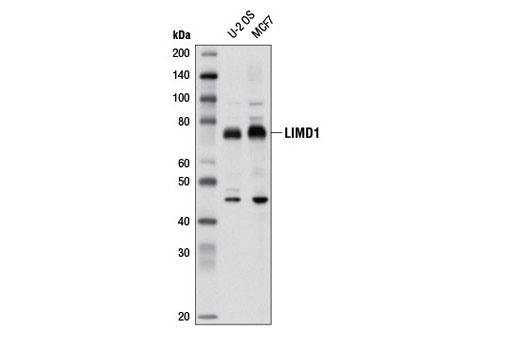WB
H M
Endogenous
72
Rabbit
#Q9UGP4
8994
Product Information
Product Usage Information
| Application | Dilution |
|---|---|
| Western Blotting | 1:1000 |
Storage
Specificity / Sensitivity
Species Reactivity:
Human, Mouse
Source / Purification
Polyclonal antibodies are produced by immunizing animals with a synthetic peptide corresponding to residues near the amino terminus of human LIMD1 protein. Antibodies are purified by protein A and peptide affinity chromatography.
Background
LIM domain-containing protein 1 (LIMD1) is a putative tumor suppressor and adapter/scaffold protein that belongs to the Ajuba family of LIM domain containing proteins. LIM domain containing proteins mediate protein-protein interactions and typically contain a pair of distinct zinc finger domains (1). Research studies indicate that LIMD1 is involved in numerous cellular processes, including inhibition of E2F mediated transcription (2) and negative regulation of the Hippo pathway through influence on YAP phosphorylation state (3,4). Additional studies identify LIMD1 as a hypoxia regulator as it recruits the Von Hippel-Lindau (VHL) protein and the hydroxylase PHD1 to a protein complex that promotes initiation of HIF-1α ubiquitination and degradation (5). Research evidence supporting the role of LIMD1 as a tumor suppressor includes the down regulation of the protein in 80% of lung cancers (6), loss of LIMD1 expression in head and neck cancers (7), and altered subcellular localization in cases of breast cancer (8).
- Schmeichel, K.L. and Beckerle, M.C. (1994) Cell 79, 211-9.
- Sharp, T.V. et al. (2004) Proc Natl Acad Sci U S A 101, 16531-6.
- Sun, G. and Irvine, K.D. (2013) Sci Signal 6, ra81.
- Reddy, B.V. and Irvine, K.D. (2013) Dev Cell 24, 459-71.
- Foxler, D.E. et al. (2012) Nat Cell Biol 14, 201-8.
- Sharp, T.V. et al. (2008) Proc Natl Acad Sci U S A 105, 19932-7.
- Ghosh, S. et al. (2010) Mol Cancer 9, 58.
- Spendlove, I. et al. (2008) Int J Cancer 123, 2247-53.
Species Reactivity
Species reactivity is determined by testing in at least one approved application (e.g., western blot).
Western Blot Buffer
IMPORTANT: For western blots, incubate membrane with diluted primary antibody in 5% w/v BSA, 1X TBS, 0.1% Tween® 20 at 4°C with gentle shaking, overnight.
Applications Key
WB: Western Blotting
Cross-Reactivity Key
H: human M: mouse R: rat Hm: hamster Mk: monkey Vir: virus Mi: mink C: chicken Dm: D. melanogaster X: Xenopus Z: zebrafish B: bovine Dg: dog Pg: pig Sc: S. cerevisiae Ce: C. elegans Hr: horse GP: Guinea Pig Rab: rabbit All: all species expected
Trademarks and Patents
Limited Uses
Except as otherwise expressly agreed in a writing signed by a legally authorized representative of CST, the following terms apply to Products provided by CST, its affiliates or its distributors. Any Customer's terms and conditions that are in addition to, or different from, those contained herein, unless separately accepted in writing by a legally authorized representative of CST, are rejected and are of no force or effect.
Products are labeled with For Research Use Only or a similar labeling statement and have not been approved, cleared, or licensed by the FDA or other regulatory foreign or domestic entity, for any purpose. Customer shall not use any Product for any diagnostic or therapeutic purpose, or otherwise in any manner that conflicts with its labeling statement. Products sold or licensed by CST are provided for Customer as the end-user and solely for research and development uses. Any use of Product for diagnostic, prophylactic or therapeutic purposes, or any purchase of Product for resale (alone or as a component) or other commercial purpose, requires a separate license from CST. Customer shall (a) not sell, license, loan, donate or otherwise transfer or make available any Product to any third party, whether alone or in combination with other materials, or use the Products to manufacture any commercial products, (b) not copy, modify, reverse engineer, decompile, disassemble or otherwise attempt to discover the underlying structure or technology of the Products, or use the Products for the purpose of developing any products or services that would compete with CST products or services, (c) not alter or remove from the Products any trademarks, trade names, logos, patent or copyright notices or markings, (d) use the Products solely in accordance with CST Product Terms of Sale and any applicable documentation, and (e) comply with any license, terms of service or similar agreement with respect to any third party products or services used by Customer in connection with the Products.
